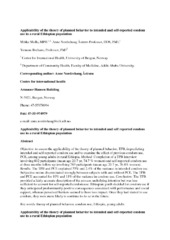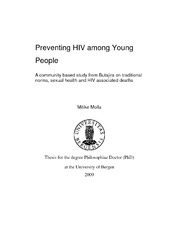| dc.contributor.author | Molla, Mitike | en_US |
| dc.date.accessioned | 2009-11-17T09:27:33Z | |
| dc.date.available | 2009-11-17T09:27:33Z | |
| dc.date.issued | 2009-05-28 | eng |
| dc.identifier.isbn | 978-82-308-0779-8 (print version) | en_US |
| dc.identifier.uri | https://hdl.handle.net/1956/3600 | |
| dc.description.abstract | Although young adults make up a large proportion of the population in developing countries, their health needs are often neglected. Sexual and reproductive health problems challenge this population in the second decade of life. HIV is one of the major health problems among young people in least developing countries, where the transmission of the disease often starts to pick up at the age of 15-24 years, more profoundly among females. Applying both qualitative and quantitative research methods, we did this study to assess risky sexual behaviours, reported sexually transmitted infections (STIs) and HIV related mortality among the rural Ethiopian youth. For the behavioural studies, we used cross-sectional design. We used a theoretical model, the theory of planned behaviour (TPB), in a three month follow-up period to see the predictive ability of the model in relation to intended and actual condom use. Data were collected using face-to-face interviews at a household level. We used data from the Butajira Rural Health Programme (BRHP) Demographic Surveillance Site (DSS), 18-years of open cohort, to assess mortality trends among young adults aged 10-24 years. We found that the traditional norm of keeping virginity until marriage is still observed among the youth in rural South Central Ethiopia. Only 3% of the nevermarried youth had premarital sex, while almost all married youth started their union as celibates. Young adults who used alcohol, chewed khat, and did not believe in the traditional norm were more likely to have premarital sex. However, we also found that married women are vulnerable to HIV and other sexually transmitted infections (STIs) because of risky sexual behaviours among their husbands. Among the sexually active youth, 4% had at least one symptom of STIs during the year preceding the study. Most of these were married women. Half of those who had STI symptoms did not seek help, mainly because of shame of having the infection in marriage and taboos related to premarital sex. Also, lack of readiness of the health services for youth sexual and reproductive health (SRH) services, unfavourable attitude of health professionals, women’s subordinate position in the society, and lack of knowledge about STIs among youth were possible reasons of the low health seeking behaviour among young people. Six out seven of the sexually active young adults never used condoms. Using the theory of planned behaviour (TPB), we found that the intention to use condoms was strongly influenced by attitude; however, in the 3-month follow up period, previous condom experience was found to be the strongest determinant of condom use in our theoretical model. The overall mortality declined during the period 1987-2004. Although declining, malaria still represents the leading reported cause of death. There were few HIV related deaths among the youth. However, low condom use, risky sexual behaviour among young married men and lack of health seeking behaviour for STIs suggest that the youth in Butajira are vulnerable to HIV and other STIs. Alcohol use and khat consumption represent risk factors for HIV related behaviour among the never-married youth, particularly in towns. Upholding the traditional norm of virginity, which helps in delaying sexual debut, prevention programmes should encourage HIV counselling and testing (HCT) before marriage, and faithfulness in marriage. Condom use among non-users should be encouraged and strengthened among ever-users to bring about consistent use in all non-mutual monogamous relations. The health services should be reoriented towards young adults’ sexual and reproductive health (SRH) to improve use. | en_US |
| dc.language.iso | eng | eng |
| dc.publisher | The University of Bergen | eng |
| dc.relation.haspart | Paper I: BMC Public Health 8(9) 2008, Mitike Molla, Yemane Berhane, Bernt Lindtjørn, Traditional values of virginity and sexual behaviour in a rural Ethiopian youth: results from a cross sectional study. Copyright 2008 Mitike Molla. This is an open-access article distributed under the terms of the Creative Commons Attribution License, which permits unrestricted use, distribution, and reproduction in any medium, provided the original author and source are credited. The published version is available at: <a href="http://dx.doi.org/10.1186/1471-2458-8-9"target=_blank>http://dx.doi.org/10.1186/1471-2458-8-9</a> | en_US |
| dc.relation.haspart | Paper II: AIDS Care 19(3): 425-431, 2007, M. Molla, A. Nordrehaug Åstrøm, Y. Brehane, Applicability of the theory of planned behavior to intended and self reported condom use in a rural Ethiopian population, pp. 425-431. Copyright 2007 Blackwell. All rights reserved. Submitted version. The published version is available at: <a href="http://dx.doi.org/10.1080/09540120600722692"target=_blank>http://dx.doi.org/10.1080/09540120600722692</a> | en_US |
| dc.relation.haspart | PAPER III: AJAR 8(2): 135-146, 2009, Molla M., Emmelin M., Berhane Y, Lindtjørn B. Readiness of youth in rural Ethiopia to seek health services for sexually transmitted infections. In press. Copyright 2009 NISC Pty Ltd. All rights reserved. Full text not available in BORA due to publisher restrictions. The published version is available at: <a href="http://dx.doi.org/10.2989/AJAR.2009.8.2.2.854"target=_blank>http://dx.doi.org/10.2989/AJAR.2009.8.2.2.854</a> | en_US |
| dc.relation.haspart | PAPER IV: Ethiopean Journal of Health Development 22(3):218-225, 2008. Molla M, Byass P, Berhane Y, Lindtjørn B. Mortality decreases among young adults in south-central Ethiopia. Copyright 2008 Mitike Molla. This is an open-access article distributed under the terms of the Creative Commons Attribution License, which permits unrestricted use, distribution, and reproduction in any medium, provided the original author and source are credited. The published version is available at: <a href="http://ejhd.uib.no/ejhd-v22-n3/ejhdv22-no3-cover.htm"target=_blank>http://ejhd.uib.no/ejhd-v22-n3/ejhdv22-no3-cover.htm</a> | en_US |
| dc.title | Preventing HIV among young people A community based study from Butajira on traditional norms, sexual health and HIV associated deaths | en_US |
| dc.type | Doctoral thesis | |
| dc.subject.nsi | VDP::Medisinske Fag: 700::Helsefag: 800::Helsetjeneste- og helseadministrasjonsforskning: 806 | nob |
| dc.subject.nsi | VDP::Medisinske Fag: 700::Helsefag: 800::Samfunnsmedisin, sosialmedisin: 801 | nob |




